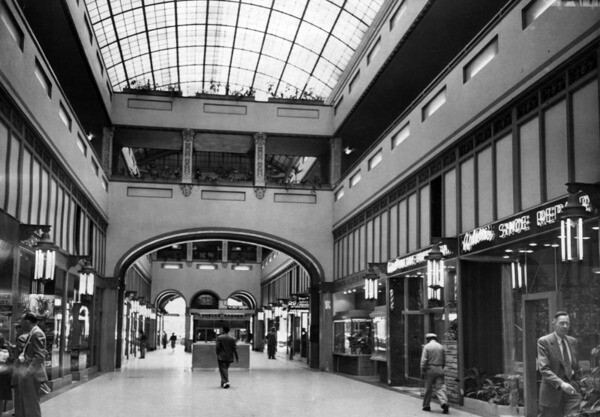Mercantile Place: The Tiny, Lost Shopping Street of Downtown L.A.

Long before the Grove, Third Street, or even Universal CityWalk, Angelenos flocked to another open-air shopping promenade: Mercantile Place -- a tiny, private street that stretched between Spring and Broadway from 1904 to 1923. At only 22 feet wide and embraced on each side by identical, two-story brick buildings, Mercantile Place created an intimate setting that stood in contrast to the rest of booming, bustling downtown Los Angeles.
Though it looked like a public street with its concrete sidewalks and paved motorway, Mercantile Place actually cut through a parcel of private property, owned by the Los Angeles Board of Education since 1883 and leased to real estate developer C. Wesley Roberts in 1904. The shopping street was the Roberts' answer to a vexing problem: though the long, rectangular parcel abutted two of the city's busiest streets, the land in the center would be virtually useless. No shopkeeper would rent a space 160 feet from the sidewalk. In a stroke of genius, Roberts built a street through the middle of the property, thus more than doubling the available frontage from 240 to nearly 600 feet.
When Mercantile Place first opened to the public on October 29, 1904, shoppers found a mix of independent businesses and branch locations of downtown's larger retailers. Shops included Citron-Favell's Women's Wardrobe, the Yamato Japanese art bazaar, and the Pe-co dance academy. Upstairs, members of the Woodmen of the World fraternal society congregated in their temple. Though the street was usually open to traffic (and became a favorite "secret" parking place among motorists), the board of education occasionally closed it to vehicles and posted signs proclaiming it a "private thoroughfare" to maintain title to the land.
In later years, retailers would complain of the chaotic street scene. Farmers' trucks sold fresh produce from the roadway, while flower vendors paraded down the sidewalks and newsstands often blocked traffic on either end. Shoppers, however, continued to visit Mercantile Place for a change of pace from the wide and more impersonal retail corridors along Broadway and Seventh Street.
It was the very success of Mercantile Place that convinced its new owners, a San Francisco-based syndicate of investors, to convert the open-air street into a $6-million enclosed arcade. Demolition began on May 1, 1923. In just eight and a half months, Mercantile Place had become the Mercantile Arcade complex -- a long promenade anchored by two twelve-story office buildings -- that still stands ninety years later. Angelenos continue to stroll under the arcade's glass skylight, tracing the path of downtown's long-lost shopping street.






L.A. as Subject is an association of more than 230 libraries, museums, official archives, cultural institutions, and private collectors. Hosted by the USC Libraries, L.A. as Subject is dedicated to preserving and telling the sometimes-hidden stories and histories of the Los Angeles region.


